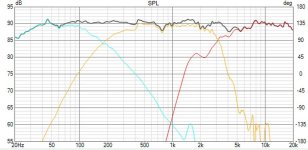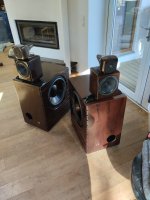Drivers:
ND25FA-4 1" Soft Dome Neodymium Tweeter 4Ohm 90dB fs=1350Hz
Crossover 3000Hz
SIG180-4 6-1/2" Signature Series Woofer 4Ohm 91dB fs=40.5Hz
Crossover 200Hz
RSS390HF-4 15" Reference HF Subwoofer 4Ohm 91.2dB fs=19.5Hz
Links:
https://www.daytonaudio.com/product/1196/nd25fa-4-1-soft-dome-neodymium-tweeter-4-ohm
https://www.daytonaudio.com/product/1916/sig180-4-6-5-signature-series-woofer-80w-driver-4-ohm
https://www.daytonaudio.com/product/126/rss390hf-4-15-reference-hf-subwoofer-4-ohm
Sealed Box Qtc=0.707 Qts=0.43 Vas=212liter
Vb=124liter
Fb=32Hz
SPL in VituixCAD:

ND25FA-4 1" Soft Dome Neodymium Tweeter 4Ohm 90dB fs=1350Hz
Crossover 3000Hz
SIG180-4 6-1/2" Signature Series Woofer 4Ohm 91dB fs=40.5Hz
Crossover 200Hz
RSS390HF-4 15" Reference HF Subwoofer 4Ohm 91.2dB fs=19.5Hz
Links:
https://www.daytonaudio.com/product/1196/nd25fa-4-1-soft-dome-neodymium-tweeter-4-ohm
https://www.daytonaudio.com/product/1916/sig180-4-6-5-signature-series-woofer-80w-driver-4-ohm
https://www.daytonaudio.com/product/126/rss390hf-4-15-reference-hf-subwoofer-4-ohm
Sealed Box Qtc=0.707 Qts=0.43 Vas=212liter
Vb=124liter
Fb=32Hz
SPL in VituixCAD:

You need to simulate baffle step unless the speaker is built into a wall. If not in the wall: Vituix can simulate this!
You have to consider the baffle step loss for woofer (and mid) and calculate the diffraction effect on the farfield FR, and then merge NF and FF FR.



Your drivers is quite like my last diy.Drivers:
ND25FA-4 1" Soft Dome Neodymium Tweeter 4Ohm 90dB fs=1350Hz
Crossover 3000Hz
SIG180-4 6-1/2" Signature Series Woofer 4Ohm 91dB fs=40.5Hz
Crossover 200Hz
RSS390HF-4 15" Reference HF Subwoofer 4Ohm 91.2dB fs=19.5Hz
Used the RSS390Ho-4 15", the SS 18M 4634t00 and a SS 9300 tweeter.
The RSS390Ho-4 in 100 liter ported, tuned to ca 22-23 hz
xover att ca 240 and 2600 hz (tried RSS390Ho-4 playing sideways, but little more ump playing forwards)
It´s a real nice combo!
For "near" lifelike experience on good recordings, from 2,9 meter listeningdistance.
Drumsolo kicks your chest 😀
Attachments
Nothing against the ND25FA, but with the quality of the other drivers I'd go with something better. To pair with the SIG180 you will want something that can go lower and/or has a waveguide.Drivers:
ND25FA-4 1" Soft Dome Neodymium Tweeter 4Ohm 90dB fs=1350Hz
Dayton RST28F or SB Acoustics SB26STAC would work and are priced nicely.
Would a very similar design be of interest to others? A recent group build of a big speaker has me thinking. Their goals are different than mine, but I have an RS390HO, and other drivers that I could use to make a design.
I have tried Enclosure Diffraction and Merger in VituixCAD.
But no luck. I just can not get it ....
But no luck. I just can not get it ....
Try this. Pad the mid, and tweeter 4dB, and try to make a smooth transition to the woofer from 1k to 100hz. The bass should simply get louder as it goes lower.
Can somebody create a SPL curve with RSS390HF and SIG180 with the diffractions.
The sealed enclosure is 124liter and for SIG180 9.4liter.
The baffle is 450x1000mm and the crossover is 200Hz LR12.
I have tried everything but can not get it to work.
The sealed enclosure is 124liter and for SIG180 9.4liter.
The baffle is 450x1000mm and the crossover is 200Hz LR12.
I have tried everything but can not get it to work.
I don't know how accurate you think a sim is without actually measuring. If you build it, you would need to measure each driver, and go from there. If you are just looking for a starting point, you can try what I suggested in post #8. Plan for the response above 1k to be 86dB. Then adjust the woofer low-pass, and mid high-pass for a gradual transition from 86dB at 1k, to 90dB at 100hz. The real speaker response will have baffle step, so the bass at 100hz will be lower than what it looks like in the sim.
Same for me.I have tried Enclosure Diffraction and Merger in VituixCAD.
But no luck. I just can not get it
VitauXcad is a complex tool, but a great tool.
Never give up trying!
- Home
- Loudspeakers
- Multi-Way
- Dayton Audio 3-way Speaker 90dB with RSS390HF 15" in VituixCAD
